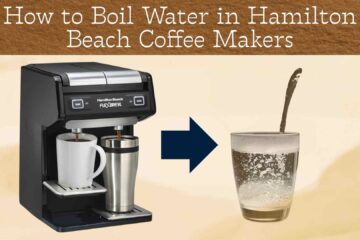There’s something magical about waking up to the aroma of freshly brewed coffee, especially when it’s as effortless as pressing a button. Keurig coffee makers have revolutionized our mornings with their unparalleled convenience, allowing us to enjoy a variety of beverages without the fuss. However, this convenience comes with the responsibility of regular maintenance to ensure your machine continues to serve you well.
Why It Matters:
Regular cleaning of your Keurig isn’t just about aesthetics; it’s crucial for several reasons:
- Preserving Coffee Flavor: Over time, coffee oils and residues can accumulate, leading to a stale or bitter taste. Regular cleaning helps maintain the rich, aromatic flavors you love.
- Ensuring Hygiene: Moist environments, like those inside your Keurig, can become breeding grounds for mold and bacteria. Routine cleaning minimizes health risks and keeps your machine hygienic.
- Extending Machine Lifespan: Mineral deposits, especially from hard water, can cause clogs and reduce efficiency. Regular descaling prevents buildup, ensuring your Keurig operates smoothly for years.
In this guide, we’ll walk you through:
- Cleaning Frequency: How often to perform daily, weekly, and monthly maintenance tasks.
- Cleaning Methods: Step-by-step instructions on how to clean each part of your Keurig effectively.
- Maintenance Tips: Best practices to keep your machine in optimal condition and enhance your coffee experience.

Why Cleaning Your Keurig Coffee Maker is Important
Prevents Build-Up of Coffee Oils and Residue:
Each cup of coffee leaves behind oils and fine particles that, if not cleaned, can accumulate over time. This buildup not only affects the taste, making it less vibrant and more bitter, but it can also become a breeding ground for mold. Regular cleaning removes these residues, ensuring each cup tastes as fresh as the first.
Ensures Hygiene and Health:
The moist, warm environment inside your Keurig is ideal for mold and bacteria growth. If left unchecked, this can lead to health concerns and unpleasant flavors. Cleaning removable parts weekly and descaling every few months helps prevent microbial growth, ensuring your coffee is both delicious and safe.
Prolongs the Lifespan of Your Keurig:
Mineral deposits from water, especially in areas with hard water, can accumulate inside your machine, leading to clogs and reduced efficiency. Descaling every 3 to 6 months removes these deposits, preventing potential damage and extending the life of your Keurig.
How Often Should You Clean Your Keurig Coffee Maker?
Daily Cleaning:
Incorporate these simple tasks into your daily routine to keep your Keurig in top shape:
- Wipe Down the Exterior: Use a soft, damp cloth to remove any coffee splashes or spills from the machine’s surface.
- Remove Used Pods: After brewing, take out used K-Cups to prevent mold growth and lingering odors.
- Rinse the Drip Tray: Empty and rinse the drip tray to prevent overflow and maintain cleanliness.
Weekly Cleaning:
Dedicate a bit more time each week to thoroughly clean removable components:
- Clean Removable Parts: Detach the pod holder assembly, water reservoir, and drip tray. Wash them with warm, soapy water, ensuring all coffee residues are removed. Dry them thoroughly before reassembling.
- Run a Cleansing Brew: With no pod inserted, run a brew cycle using water to clear any residual coffee oils and flavors from the brewing system.
Monthly or Periodic Cleaning:
For deeper maintenance:
- Descale the Machine: Depending on your water hardness and usage, descaling every 3 to 6 months is recommended. Use a descaling solution or white vinegar to remove mineral deposits that can affect performance.
- Replace Water Filter: If your model uses a water filter, replace it every two months or after 60 tank refills to ensure optimal water quality and taste.
Step-by-Step Guide to Cleaning Your Keurig Coffee Maker
Regular cleaning ensures your Keurig operates efficiently and your coffee tastes great. Here’s a detailed guide to help you through the process:
What You’ll Need:
- Water: Filtered or distilled water is preferable to prevent mineral buildup.
- White Vinegar: Effective for descaling and removing mineral deposits.
- Dish Soap: Mild, non-abrasive soap for cleaning removable parts.
- Soft Cloth or Sponge: For wiping surfaces without causing scratches.
- Large Mug: To catch water during the cleaning cycles.
Step 1: Clean the Exterior and Drip Tray
- Wipe Down the Exterior: Ensure the machine is unplugged. Use a soft cloth dampened with warm, soapy water to gently clean the exterior surfaces. Avoid abrasive cleaners to prevent damage.
- Clean the Drip Tray: Remove the drip tray and wash it with warm, soapy water. Rinse and dry thoroughly before reattaching.
Step 2: Clean the K-Cup Holder and Pod Area
- Remove the K-Cup Holder: Gently pull out the K-Cup holder from the machine.
- Disassemble and Clean: Separate the funnel from the holder. Wash both pieces with warm, soapy water, using a sponge to remove any coffee grounds.
- Dry and Reassemble: Ensure all parts are completely dry before reassembling and reinserting into the machine.
Step 3: Descale Your Keurig
- Prepare the Descaling Solution: Fill the water reservoir with a mixture of equal parts white vinegar and water.
- Initiate Descaling Mode: Place a large mug on the drip tray. Without inserting a K-Cup, run a brew cycle, using the largest cup setting.
- Repeat the Process: Continue brewing with the vinegar solution until the reservoir is empty.
- Rinse: Fill the reservoir with fresh water and run multiple brew cycles to flush out any remaining vinegar taste.
Step 4: Clean the Water Reservoir
- Remove and Clean: Take out the water reservoir and lid. Wash them with warm, soapy water, ensuring all areas are cleaned.
- Dry and Reattach: Dry thoroughly before placing back onto the machine.
Step 5: Clean the Needle and Internal Parts
- Access the Needle: Refer to your Keurig model’s manual to locate the entrance needle.
- Clean the Needle: Use a paperclip or needle-cleaning tool to gently remove any coffee grounds from the needle. Be cautious to avoid injury.
- Reassemble: Once cleaned, reassemble any parts you’ve removed and ensure everything is securely in place.
For a visual demonstration, you might find this video helpful:
Signs Your Keurig Needs Cleaning
Regular maintenance is key to a long-lasting and efficient coffee maker. Here are some signs that indicate it’s time to clean your Keurig:
- Slow Brew Time: If your Keurig takes longer than usual to brew a cup of coffee, it may be due to mineral buildup affecting the heating element and water flow. Descaling can help restore normal brewing time.
- Bad Taste or Odor: Unpleasant flavors or smells in your coffee can result from mold, bacteria, or coffee oil buildup within the machine. Regular cleaning helps maintain the freshness and taste of your brews.
- Water Not Flowing Properly: If water doesn’t flow correctly during brewing, it might indicate clogs in the needle or water lines due to mineral deposits or coffee grounds. Cleaning these components can resolve the issue.
- Visible Mold or Mildew: Finding mold or mildew in the water reservoir, K-Cup holder, or other parts of your Keurig is a clear sign that cleaning is overdue. Addressing this promptly is essential for health and taste reasons.
Tips for Maintaining a Clean Keurig
Regular maintenance not only extends the lifespan of your Keurig coffee maker but also ensures each cup of coffee is as delicious as the last. Here are some friendly tips to keep your machine in optimal condition:
Use Filtered Water:
Opting for filtered or bottled water can significantly reduce mineral buildup inside your Keurig. Minerals like calcium can accumulate over time, leading to clogs and affecting the taste of your coffee. Filtered water helps prevent this buildup, ensuring smoother operation and better-tasting brews.
Regular Maintenance Schedule:
Establishing a consistent cleaning routine is key to a well-functioning Keurig:
- Monthly: Clean removable parts such as the drip tray, water reservoir, and K-Cup holder with warm, soapy water. This prevents coffee residue and mold growth.
- Every 3-6 Months: Perform a thorough descaling process using a descaling solution or white vinegar to eliminate mineral deposits. This helps maintain the heating element’s efficiency and prolongs the machine’s lifespan.
Store the Keurig Properly:
When not in use for extended periods, store your Keurig in a dry, cool place. Ensure it’s unplugged and that all parts are clean and dry to prevent mold and mildew growth. Proper storage minimizes the need for frequent deep cleanings and keeps your machine ready for use when you need it.
Troubleshooting Common Issues Caused by a Dirty Keurig
Even with regular maintenance, you might encounter some common issues. Here’s how to address them:
Water Dripping Slowly or Not Brewing at All:
If your Keurig is brewing slowly or not at all, mineral buildup could be obstructing water flow. Performing a descaling process can clear these blockages and restore normal function. Use a descaling solution or white vinegar, following the manufacturer’s instructions.
Clogged Needles:
Coffee grounds or debris can clog the needles responsible for puncturing K-Cups, leading to brewing issues. To clean the needles:
- Turn Off and Unplug: Ensure the machine is off and unplugged for safety.
- Remove the K-Cup Holder: Gently pull out the K-Cup holder and separate its components.
- Clean the Needles: Use a paperclip or needle-cleaning tool to dislodge any coffee grounds from the needles.
- Rinse and Reassemble: Wash the K-Cup holder parts with warm, soapy water, rinse thoroughly, and reassemble.
Unusual Noises or Malfunctions:
Strange noises or malfunctions can result from debris or mineral deposits affecting internal components. To address this:
- Perform a Clean Cycle: Run a brew cycle without a K-Cup using water to flush out any debris.
- Descale the Machine: Regular descaling helps prevent mineral buildup that can cause operational issues.
- Check for Obstructions: Ensure there are no coffee grounds or debris in the needle area or water lines.
If problems persist after these steps, consult the user manual or contact Keurig customer support for further assistance.
Best Products for Cleaning Your Keurig
Using the right cleaning products ensures your Keurig remains in top condition without causing damage. Here are some recommended options:
Commercial Descaling Solutions:
- Keurig Descaling Solution: Specifically formulated for Keurig machines, this solution effectively removes mineral buildup without harsh chemicals.
- Urnex Dezcal Descaler: A trusted descaling agent compatible with various coffee makers, including Keurig.
DIY Solutions (Vinegar & Water):

A mixture of white vinegar and water is an affordable and effective alternative for descaling:
- Mix equal parts white vinegar and water.
- Fill the water reservoir with the solution.
- Run a brew cycle without a K-Cup, discarding the liquid.
- Repeat the process until the reservoir is empty.
- Follow up with several water-only cycles to rinse.
Keurig-Specific Cleaning Tools:
- Keurig Needle Cleaning Tool: Designed to safely clean the needles without damaging internal components.
- Keurig Water Filter: Using filtered water helps prevent mineral buildup and improve coffee taste.
Incorporating these products into your maintenance routine will help keep your Keurig brewing delicious coffee for years to come.
Conclusion
Regular cleaning of your Keurig coffee maker is essential for maintaining its performance, extending its lifespan, and ensuring each cup of coffee tastes as delightful as the last. By incorporating simple tasks like using filtered water, establishing a consistent cleaning schedule, and storing your machine properly, you can enjoy hassle-free brewing for years to come.
- Use Filtered Water: Helps prevent mineral buildup, ensuring better-tasting coffee and reducing the need for frequent descaling.
- Regular Maintenance Schedule: Perform daily, weekly, and monthly cleaning tasks to keep your machine in optimal condition.
- Proper Storage: When not in use, store your Keurig in a dry, cool place to prevent mold and mildew growth.
By following these practices, you can enhance your coffee experience and prolong the life of your Keurig coffee maker.
We’d love to hear about your cleaning routines and any tips you’ve found helpful in maintaining your Keurig. Feel free to share your experiences or ask any questions in the comments below!
FAQs (Frequently Asked Questions)
Can I use vinegar to clean my Keurig?
Yes, white distilled vinegar is an effective and natural solution for descaling your Keurig coffee maker. Its acidity helps break down mineral deposits that can accumulate over time. To use vinegar for cleaning:
- Prepare the Solution: Mix equal parts of white distilled vinegar and water.
- Fill the Reservoir: Pour the solution into the water reservoir of your Keurig.
- Run the Brew Cycle: Place a mug on the drip tray, start the brew cycle without a K-Cup, and let the solution flow into the mug.
- Repeat: Continue running the brew cycle until the reservoir is empty, discarding the contents of the mug after each cycle.
- Rinse: Fill the reservoir with fresh water and run several brew cycles to ensure all vinegar residues are removed.
This method helps remove mineral buildup and keeps your machine running smoothly.
What happens if I don’t clean my Keurig regularly?
Neglecting regular cleaning of your Keurig can lead to several issues:
- Mineral Buildup: Over time, minerals from water can accumulate inside the machine, leading to clogs and affecting the heating element’s efficiency. This buildup can cause slower brewing times and inconsistent coffee temperatures.
- Poor Coffee Quality: Residual coffee oils and grounds can impart stale or bitter flavors to your coffee, diminishing the overall taste.
- Machine Malfunction: A lack of cleaning can result in mechanical issues, such as the machine not brewing properly or failing to heat water adequately.
Regular maintenance helps prevent these problems, ensuring your Keurig operates efficiently and your coffee tastes great.
How can I remove mineral buildup from my Keurig?
To effectively remove mineral buildup (scale) from your Keurig, regular descaling is essential:
- Frequency: Descale your Keurig every 3 to 6 months, or more frequently if you have hard water.
- Method: Use a descaling solution recommended by Keurig or a mixture of white distilled vinegar and water (equal parts). Fill the water reservoir with the solution, run a brew cycle without a K-Cup, and repeat until the reservoir is empty. Then, run several cycles with fresh water to rinse.
This process helps dissolve mineral deposits, preventing clogs and maintaining the machine’s efficiency.
How long will my Keurig last if I clean it regularly?
With regular cleaning and maintenance, a Keurig coffee maker can last between 3 to 5 years. Proper upkeep not only extends the machine’s lifespan but also ensures consistent performance and quality coffee.
Is it necessary to clean the K-Cup holder every time?
While it’s not necessary to clean the K-Cup holder after every single use, it’s important to clean it regularly to prevent coffee grounds buildup and potential mold growth. Aim to clean the K-Cup holder and its components at least once a week or more frequently if you use your Keurig multiple times a day.



0 Comments